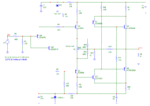boylesg
Advanced Member level 4
- Joined
- Jul 15, 2012
- Messages
- 1,023
- Helped
- 5
- Reputation
- 10
- Reaction score
- 6
- Trophy points
- 1,318
- Location
- Epping, Victoria, Australia
- Activity points
- 11,697
Can some one please explain to me what open loop and closed loop followers are in relation to these?
I found this (https://www.audioasylum.com/forums/prophead/messages/4692.html) but it doesn't really explain what they mean exactly.
I have a pretty good idea of what a 'follower' is, e.g. a class A amplifier with no voltage or current gain where the input current and voltage equal the output voltage and current, generally used as a buffer between entities with mismatching input and output impedance.
And also can anyone suggest a practical sziklai and darling pair using BD139/BD140 and BC547/BC548 for example with an appropriate bypass resistor value?
Or else point me in the direction of a website that details construction of specific example pairs rather than just theoretical stuff?
I found this (https://www.audioasylum.com/forums/prophead/messages/4692.html) but it doesn't really explain what they mean exactly.
I have a pretty good idea of what a 'follower' is, e.g. a class A amplifier with no voltage or current gain where the input current and voltage equal the output voltage and current, generally used as a buffer between entities with mismatching input and output impedance.
And also can anyone suggest a practical sziklai and darling pair using BD139/BD140 and BC547/BC548 for example with an appropriate bypass resistor value?
Or else point me in the direction of a website that details construction of specific example pairs rather than just theoretical stuff?
